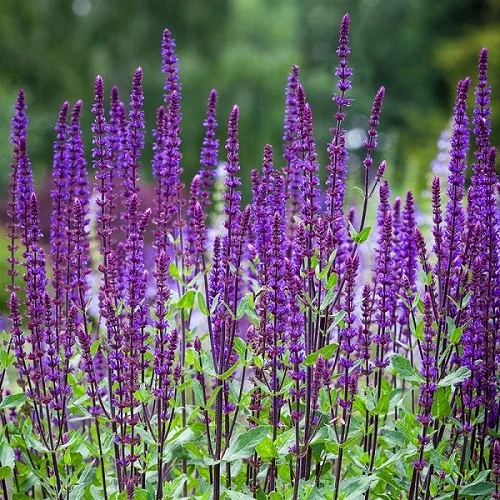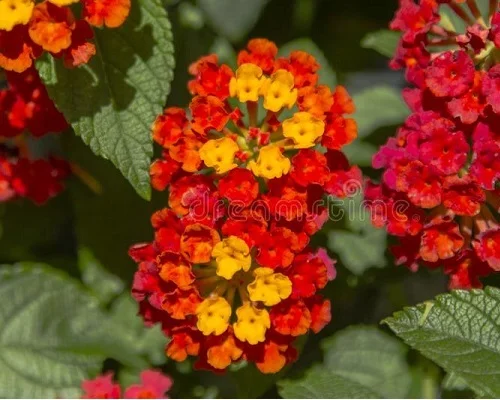Camellia japonica : How to Grow and Care for Japanese Camellia (Common Camellia)
Some links in this post may be affiliate links
Camellia japonica commonly called Japanese Camellia or Common Camellia is a slow growing, flowering shrub which bears alternately arranged leathery leaves, dark-green on top and paler on the undersides.
The leaves margins are finely toothed, pointed at the tip and are rich in anti-inflammatory terpenoids like lupeol and squaline. The youngest branches are purplish brown and become grayish brown as they age.
Japanese Camellia belongs to the Theaceae (Tea) family together with Camellia sinensis (tea plant) and Camellia sasanqua.
The name 'Camellia' is Latin for 'helper of the priest' and was named for the Jesuit priest botanist, Georg Joseph Kamel, who used plants to help the sick. 'Japonica' is in reference to the native territory of the species.
Common Camellia is the state flower of Alabama. Japanese Camellia symbolizes love, affection, adoration, longing and eternal love.
Japanese Camellia is ideal for USDA Hardiness Zones 7-9 and can tolerate down to a temperature of 100F (-120C) for a short period.
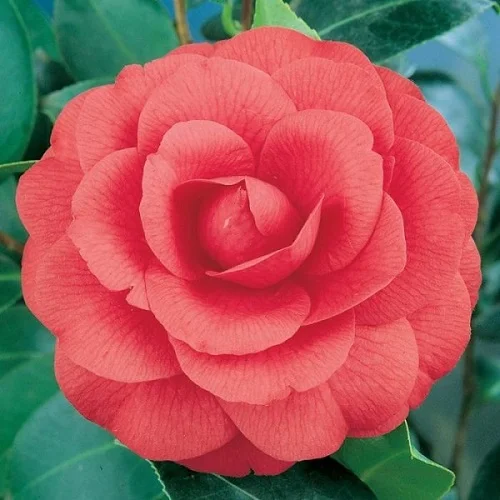
Botanical name: Camellia japonica
Family: Theaceae
Common names: Japanese Camellia, Common Camellia
Origin
Camellia japonica is native to mainland China, Taiwan, Southern Korea and southwestern Japan in forests at altitudes of 980-3600 feet above sea leavel.
Size
Japanese Camellia grows to a height of 5-8 feet and 5-10 feet wide in decades.
Flowers
The flowers in Common Camellia appear along the branches towards the end on very short stems. They occur alone or in pairs and are about 2-4 inches diameter in shades of white, red, pink, purple and variegated. The blooms appear in late winter through spring. The flowers are attractive to honey bees and hummingbirds.
Cultivars
Japanese Camellia comes in many cultivars and hybrids. Many of the plants grown nowadays are hybrids which are more hardy than the mother plants.
Some of the common Common Camellia include;
- Korean Fire: which bears red flowers and is ideal for USDA Zones 6-9.
- Betty Sheffield Supreme: bears large white petals with red and pink blotched borders.
- Kramer's Surprise: is a fragrant cultivar which bears brilliant red peony-like flowers.
- Ave Maria: bears medium sized flowers in a delicate shade of silvery pink.
- Carter's Sunset: bears large, semi-double peony-like flowers and has a long blooming season.
- Desire: has double flowers in pure white to pale bluish pink edged with a deeper pink.
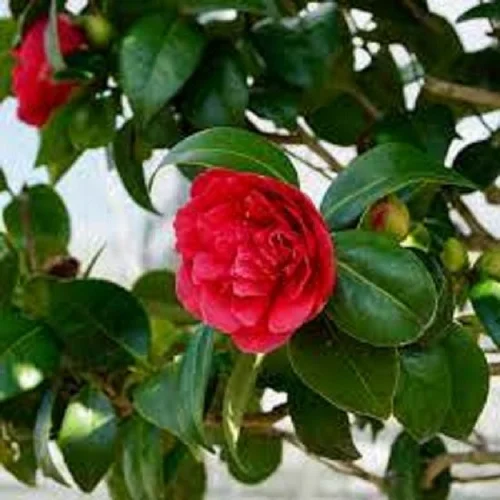
Camellia japonica (Japanese Camellia) Care
Japanese Camellia grows best in partial shade, constantly warm conditions and consistently moist, well-drained soil that is rich in organic matter to promote lush growth and flowering.
Camellia japonica requires timely pruning to keep the plant neat, to control growth, to encourage branching and to minimize pest and disease infestations as it improves aeration.
Light Requirements
Japanese Camellia thrives in partial shade or dappled sunlight through out the growing season to boost growth and promote blooming. Mature plants can tolerate full sunlight but the young plants need to be protected from intense, direct afternoon sun.
Water Requirements
In the early stages after planting, water the young Japanese Camellia regularly to maintain the soil consistently moist until the plants are well established.
Once established, Camellia japonica is fairly drought-tolerant and will not require very frequent watering. Water the established plant moderately during the growing season while allowing the soil dry out between waterings.
To retain moisure and also minimize growth of weeds, apply a mulch on the soil surface. Avoid overwatering or soggy soil as well as underwatering (too dry soil) as they can result in flower bud drop and hence reduced flowers.
Temperature and Humidity
Japanese Camellia requires constantly warm temperatures but can withstand temperatures down to -120C for short periods. Avoid growing the plant in windy conditions to prevent sudden flactuations in temperatures which can lead to flower bud drop. Keep it sheltered against cold winter winds.
Soil
The best soil for Camellia japonica should be consistently moist, free-draining, rich in organic matter and slightly acidic at a PH of 6.0 to 6.5. Use a soil PH meter to confirm it is within this range. If the PH is not within the recommended range, it should be ammended.
To increase PH (if it is too acidic) which is indicated by yellow leaves, add lime to the soil. To decrease PH (if it is too alkaline), add soil sulphur. Allow a 2 weeks period for the soil to correct the PH.
Where the soils are clay, grow the plant in containers. Check out this quality potting mix on Amazon for container grown Japanese Camellia.
Fertilizer (Feeding)
Feed Japanese Camellia with a nitrogen-rich, slow release fertilizer in spring to promote a lush growth of healthy foliage. To boost flower production, feed the plant monthly in summer with a fertilizer formulated for acid-loving plants.
Where to Buy Japanese Camellia
Japanese Camellias plants and seeds are available online on Etsy (Link to Etsy).
Starting Japanese Camellia Seeds
Soak the Japanese Camellia seeds for 24 hours or crack the hard coat to enhance germination.
Sow the seeds free-draining, loose fertile soil and cover the set up with a clear plastic to maintain a warm and humid environment.
Maintain the soil moist through out but avoid soggy soil. Germination should occur in 4-12 weeks.
Once germinated, move the plants to individual pots and cover the set up with a clear plastic to create a greenhouse effect (warm and moist conditions.
Transplant the seedlings in spring when the temperature are adequately warm when they are about 6-8 inches tall.
When to Plant Japanese Camellia in the Ground
The best time to plant Japanese Camellia in the ground is in spring after the threat of frost has passed and the soil has warmed up enough.
Planting Japanese Camellia in the Ground
Dig up the soil to a depth of about 10-12 inches to loosen it and get rid of all the weeds and other debris from the soil.
Prepare planting holes at a spacing of 10-15 feet. Ensure that the holes are four times as wide as the rootballs and as deep as rootballs.
Plant the plant at the same depth as they were in their pot. Firm the soil around the root ball lightly.
Thoroughly water the plants and maintain the soil moist until the plants are well established. Thereafter, water moderately while allowing the soil to dry out between waterings.
Apply a layer of mulch to keep the soil moist and also discourage growth of weeds.
Where to Plant Japanese Camellia
Plant Japanese Camellia in borders, beds, hedges, fences, patios and containers.
Overwintering Japanese Camellia
To protect Japanese Camellia during winter, cover the roots with a thick, mounded layer of dry leaves. This will keep the soil warm and thus enhance resprouting in spring when temperatures warm up.
Where the winters are very harsh, grow the plant in containers which can be brought inside. Avoid excessive humidity and sudden changes in temperatures; maintain the temperatures at about 12.70C (550F to prevent flower bud drop.
Repotting Container-grown Japanese Camellia
Where the conditions are not favourable for growing Japanese Camellia in the ground like in areas with harsh winters, you can grow the plants in containers.
Doing so allows you to move the plants indoors when the conditions are harsh in winter.
Repot Japanese Camellia every 2-3 years at the beginning of the growing season (spring). Use a pot that is large enough to accomodate the roots.
Confirm that the container has adequate drainage holes to prevent the soil from getting soggy to prevent root-rot and eventual loss of the plant.
Slip the plant out of its nursery pot and place it in the center of the container at the same soil level as it was in the previous pot and back fill with fresh, free-draining soil that is rich in organic matter.
Do not fill the pot completely but allow a space of about 1 in. from the rim for watering purposes to avoid spillage.
Wet the soil thoroughly until water comes out through the drainage hole(s). Thereafter, water moderately during the growing season when the top 2-3 inches of soil dry out. Reduce watering in the cold season (winter).
Pruning Japanese Camellia
Pruning Japanese Camellia involves removing dead and damaged branches and long, heavy shoots immediately after flowering or in early summer to stimulate branching.
Avoid late pruning in the year as it can result in removal of flower buds leading to reduced blooms.
Remove spent flowers to keep the plant neat and tidy as well as discourage pest and disease infestations.
Use a sharp, sterilized pair of scissors to minimize unnecessary injury and transmission of fungal and bacterial diseases.
Propagation
Japanese Camellia (Camellia japonica) can be propagated during the growing season by layering or from stem cuttings.
How to propagate Japanese Camellia by Layering
Layering Japanese Camellia is best done during summer.
Bend a long stem to the ground, wound the area, hold it with a peg and bury the wounded are underground to encourage rooting.
Once rooted, detach the stem from the mother plant and plant it seperately to establish a new plant.
Water the new plant thoroughly and maintain the soil moist through out until they are well-established after which you can begin routine care.
How to propagate Japanese Camellia from Stem Cuttings
Cut a fresh Japanese Camellia stem with 5-6 leaf nodes from the tip.
Divide the stem into 4 in. sections with 2 sets of leaves, remove the bottom leaves and dip the lower cut end in a rooting hormone to enhance rooting.
Insert the lower cut end in a 4 inches pot in damp, well-draining, potting soil.
Cover the set up with clear, plastic and place in warm place under bright indirect light.
Maintain the soil moist through out until the new plant is well established.
Once the roots have filled the pot transplant the new plant in spring and begin routine care.
How to Promote Blooming in Japanese Camellia
Keep the soil consistently moist but not soggy. Do not allow the soil to become saturated or too dry to avoid flower bud drop.
Ensure that the plant receives bright, indirect light and avoid too much sun. Protect the plant from intense sunlight.
Carry out proper pruning of the Japanese Camellia; remove all the flower buds but one in each cluster to increase bloom size.
Protect the Camellia japonica from windy winter conditions to avoid flower bud drop. Feed the plant monthly in summer with a fertilizer formulated for acid-loving plants.
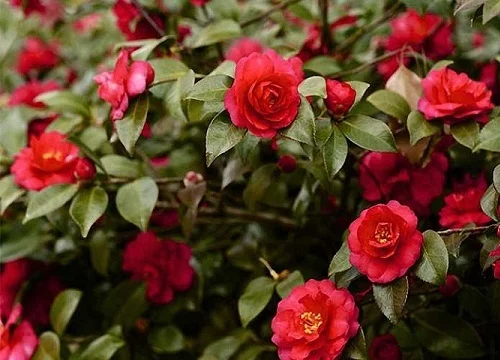
Japanese Camellia Problems
Japanese Camellia (Camellia japonica) problems include lack of blooms, pests and disease.
Lack of blooms
Lack of blooms in Japanese Camellia is caused by a number of varied reasons. One of the cause of lack of blooms is inadequate light. Ensure that the plant receives at bright indirect light (dappled light) during the growing season. Too little light or too intense sunlight will reduce flower production.
The second reason for lack of blooms in Japanese Camellia is insufficient feeding. To promote blooming, feed the plant monthly in summer with a fertilizer formulated for acid-loving plants.
The third cause of lack of blooms in Japanese Camellia is improper water; either overwatering or underwatering. Maintain the soil consistently moist but not saturated. Do not allow the soil to become saturated or too dry out completely to prevent flower bud drop.
The fourth cause of lack of blooms in Common Camellia is sudden changes in temperatures. Keep the plant from windy winter conditions to avoid flower bud drop.
Pests
Common pests in Japanese Camellia are scale insects, aphids, thrips, mealybugs and spidermites which suck the plant sap resulting in flower bud drop. Spray the plant with an insecticidal soap or neem oil to get rid of the pests. Make sure to follow the manufacturer's instructions.
Diseases
Common diseases in Japanese Camellia include leaf spot, black mold, and root-rot among others.
- Leaf Spot: Appears as small circular spots on the leaves and is prevalent in poorly aerated, overdamp conditions.
- Black Mold: Sooty Mold is a black mold which grows on the sticky honeydew deposited by aphids, scales, mealy bugs and whiteflies.
- Root-rot: Which is common in container-grown plants and plants grown in poorly drained soils as soggy soil enhances the growth of the causative fungi.
Do not overwater the plants or let them sit in soggy soil. Ensure that the soil is free-draining and water only when the soil has dried out.
For container-grown plants, make sure that the container has adequate drainage holes and that the soil is drains easily.
Avoid overcrowding of the plants and also prune some of the branches to improve the ventilation and ensure that there is good air circulation at all times.
The sooty mould reduces plant growth and vigour by blocking pores and shading the leaf surface area for sunlight absorption.
To remove the sooty mould, clean the plant by wiping with a damp soft cloth and rinse with warm water.
To prevent future attacks, deal promptly with the pests which produce the sticky honeydew.
For container-grown plants; Take out the plant from its pot and inspect the roots. Mushy brown-black roots are indicative of root-rot. Cut away the infected roots. Spray the healthy roots and the entire plant with a copper-based fungicidal solution.
Repot the plant in a fresh pot and fresh, well-drained soil. Ensure that the pot has adequate drainage holes. Position the plant in a sunny spot. Do not water and keep the soil dry for a few days.
You liked it? Share on social media.
Related Content
Amazon Associates Disclosure
Homeplantsguide.com is a participant in the Amazon Services LLC Associates Program, an affiliate advertising program designed to provide a means for sites to earn advertising fees by advertising and linking to amazon.com.

